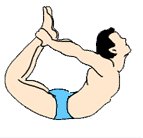At such times it is important for us to take care of ourselves. Dr. Rachna, Yoga, and Natouropathy Specialist and founder of YogAdda.com shared with us some breathing exercises that will help you strengthen your lungs.
Despite the fact that our lungs are
highly sensitive and have internal organs, with each of our breaths these are
constantly unfolding with our external environment. This puts them at risk for
dust, pollution as well as respiratory infections and we should protect them by
practicing good hygiene. Even in the yogic sense the lungs are the primary
organs that help us to control and augment the "life" or universal
life-giving energy. This is why the practice of yoga breathing is called
pranayama.
These methods improve overall health, give us greater vitality, manage stress and increase our immunity. Nowadays, pranayama exercises have become particularly relevant because COVID-19 is a respiratory infection that attacks our lungs. So, in addition to relentlessly practicing preventive measures such as washing our hands, wearing masks, and social distance, we should also work on interventions that can keep the lungs healthy and vigorous.
Here are a few ways to strengthen your lungs:
Practice Surya Namasakra (Sun Salutations)
Surya Namaskar is a sequence of 12 yoga
exercises that you practice in coordination with breathing. Thus, it is a
dynamic combination of pranayama and asana and benefits both of us. More
importantly, in Surya Namaskar, you alternatively give a great
extension to the spine and chest with forward and backward bending movements,
tracheal prescribed patterns, improve overall oxygenation levels and strengthen
the respiratory muscles. Throughout medical studies, sun salutations have been
shown to improve breathing ability and resilience tolerance as it improves our
respiration and respiratory capacity.
If you aim to practice 6-12 rounds of Surya Namaskar during the day at medium speed, it would be best which one round includes both right and left side.
Adham Pranayama (Deep Belly Breathing or Diaphragmatic Breathing)
It is an initial respiratory tract that
helps us to correct our breathing patterns. To do this exercise, you bend your
knees and lie on your back and place one hand on the abdomen, above the navel.
You then inhale through the nose to draw air into the deepest region of the
lungs. As the lungs expand with air they push the diaphragm, which pushes out
the abdomen. You will notice that your abdominal arms will expand when you
breathe. And then you can breathe normally
Variations
DEEP BELLY BREATHING
2) Prone to breathing: You can practice
dry breathing while lying down (with your head down) and keeping your head back
on the palm of your hand like a crocodile (crocodile posture). Covid-19
patients are reported to benefit from the prone position, especially ventilator
patients, which reduces the pressure on the lungs. In addition to the hands, it
is considered a good location for lung training for pranayama.
These procedures help to activate our lung diaphragm and dormant regions, remove stale air trapped in the lungs and increase our overall respiratory capacity.
It is a forceful practice of breathing
with short but intense strokes of excitement that is done in rapid succession.
Inhalation in the forehead is passive and occurs spontaneously. This exercise
helps us train the diaphragm muscles, forcing stale air from the lungs,
creating more space for more fresh air and clearing the nasal passages. This is
a heating exercise and should not be done without consulting a doctor in people
with high blood pressure, dizziness, or heart problems.
You can practice three rounds of Kapalbharati and take one hundred breaths in each round. This should be done on an empty stomach and should be done best before starting your yoga practice.
Nadi Shuddhi (Alternate Nostril Breathing) also known as Anulom Vilom
This is a calm, balanced breathing exercise in which you inhale and exhale very gently and slowly from the alternate nose. It is one of the oldest breathing techniques found in many yoga texts because it helps you unclog your energy channels, making you lighter and clearer towards practicing meditation.
Medically speaking, it has been found to be very helpful in managing stress and anxiety due to slowed breathing, breathing and improving breathing. This gives the lungs more time to exchange air, which increases the overall efficiency of the breathing process, and we should also note that reducing stress and anxiety is also a major positive effect of this exercise. The lungs are very sensitive to stress and anxiety, in particular, it can make you breathe, make you feel short of breath or feel tight in the chest. It does not help being similar to a symptom of COVID-19 and increases our stress.
Club scrubbing can be practiced on an empty stomach for 5-10 minutes. It is best to do this after practicing yoga asana like some physical movements; Both nostrils will remain open, allowing you to breathe comfortably and evenly on both sides.
To this end, none of these exercises should be performed in crowded, polluted, or unsanitary places when you are taking deep breaths; You also run the risk of dragging germs deep into your lungs. Fresh morning air in a perfect private setting.
Doing these exercises regularly will help you maintain good health and vitality as the practice of yoga affects both body and mind. So we are not only developing good immunity, but also the mental resilience we need to deal with this pandemic. It is a win-win situation for everyone.








0 Comments
Post a Comment